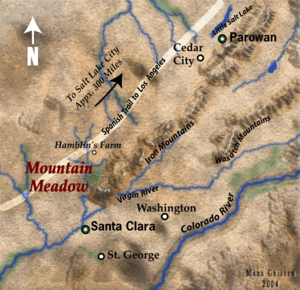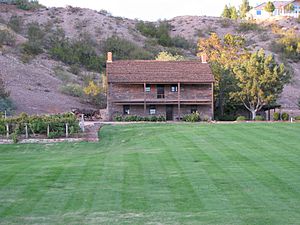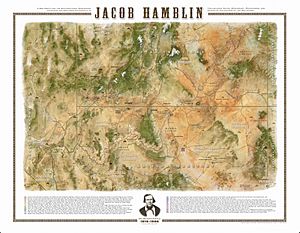Jacob Hamblin facts for kids
Quick facts for kids
Jacob Hamblin
|
|
|---|---|

Jacob Hamblin, the Latter-day Saints' Apostle to the Indians,
scout, and colonist of the American West |
|
| Born | April 2, 1819 Ashtabula County, Ohio, U.S.
|
| Died | August 31, 1886 (aged 67) Pleasanton, New Mexico, U.S.
|
| Spouse(s) | Lucinda Taylor, Rachel Judd, Sarah Priscilla Leavitt, Louisa Boneli |
Jacob Hamblin (born April 2, 1819 – died August 31, 1886) was an important figure in the American Old West. He was a pioneer and a missionary for the Church of Jesus Christ of Latter-day Saints. He also worked as a diplomat with many Native American tribes in the Southwest and Great Basin regions.
Hamblin helped European-American settlers move into southern Utah and northern Arizona. People saw him as a fair and honest person who could help Latter-day Saint settlers and Native Americans get along. He was sometimes called the "Buckskin Apostle" or the "Apostle to the Lamanites." In 1958, he was honored in the Hall of Great Westerners at the National Cowboy & Western Heritage Museum.
Contents
Jacob Hamblin: Early Life and Family
Hamblin was born in Salem, Ohio, into a family of farmers. He learned how to farm as he grew up. He joined the Church of Christ on March 3, 1842, when he was 22 years old.
Jacob and his first wife, Lucinda, had four children. When Jacob wanted to move west with the Latter-day Saints to the Salt Lake Valley, Lucinda did not want to go. In 1849, they decided to end their marriage. Jacob then traveled west with his four children. Later that year, he married Rachel Judd, a widow, in Council Bluffs, Iowa. Jacob and Rachel had five children together.
Jacob Hamblin also practiced plural marriage, which was a belief among some Mormons at the time. He married Sarah Priscilla Leavitt in 1857 and Louisa Bonelli in 1865. He had 14 children with Sarah and 6 with Louisa. He also helped raise Clara, a child from another marriage.
Moving West and Becoming a Peacemaker
As a young man, Hamblin lived in Spring Prairie, Wisconsin. He was once badly injured and thought he might die. He prayed to God, promising to serve Him for the rest of his life if he survived. Soon after, a nurse came to his door, saying she felt called to help him. She had the right medicines and helped him heal.
After this experience, Hamblin became very religious. In 1842, he and his children joined Mormonism. They moved from Wisconsin to Nauvoo, Illinois, where many Latter-day Saints lived. After the death of Joseph Smith, the church's founder, Jacob supported Brigham Young as the new leader.
In 1850, Hamblin settled in Tooele, near Salt Lake City. He became known for building good relationships between white settlers and Native Americans. After one difficult event, Jacob felt that God wanted him to be a "messenger of peace" to the Native Americans. He believed that if he did not seek to harm them, they would not harm him. In 1854, Brigham Young asked Hamblin to serve a mission to the southern Paiute Indians. He then settled in Santa Clara, near the modern city of St. George, Utah.
Hamblin's first home in Santa Clara was destroyed by a flood. His second wife, Rachel, saved one of their young children from drowning, but the child sadly died later from being too cold. Rachel also became ill from the flood. To avoid future floods, Hamblin built a new home on a hill in Santa Clara. Today, this house is a museum run by the LDS Church.
Jacob Hamblin and the Mountain Meadows
In August 1857, Brigham Young made Hamblin the leader of the Santa Clara Indian Mission. Young had learned that the United States army was coming to Utah. This event became known as the Utah War. Young told Hamblin to make sure the settlers kept their guns and ammunition. He also wrote that Native Americans "must learn to help us or the United States will kill us both."
In late August, Hamblin traveled north. He met a group of travelers called the Baker–Fancher party, who were heading to California. Hamblin suggested they stop at the Mountain Meadows, a place where he had a home. This was a common stopping point on the Old Spanish Trail.
Hamblin continued to Salt Lake City for about a week to meet with church leaders and deal with Native American matters. He later said he heard that the Fancher party had caused trouble and used bad language. When Hamblin was on his way home, he learned about the terrible Mountain Meadows massacre, where many of the Fancher party were killed.
Hamblin was very upset by the massacre. He met John D. Lee, who was involved in the killings. Hamblin later testified that Lee admitted his role, though Lee blamed the Paiutes. Many people believed Hamblin because he was known for being very honest.
As Hamblin continued south, he heard that another group of Paiutes planned to attack a different wagon train. He quickly sent others ahead to prevent another tragedy. They were able to talk with the Paiutes, who took the wagons' cattle but left the travelers in peace.
When Hamblin reached the massacre site, his third wife, Sarah, was with him. She later wrote about the horror of the scene. The children who survived the massacre were brought to the Hamblin home. Sarah cared for some of them. Later, federal agents returned these children to their families in Arkansas.
Hamblin spent the rest of 1857 and early 1858 helping non-Mormons travel through Utah and helping Mormons return to Utah for defense. After the Utah War ended, Hamblin was willing to share what he knew about the massacre. He later testified at John D. Lee's second trial in 1876.
Jacob Hamblin: Diplomat to Native Americans

In 1858, Hamblin became a sub-Indian agent. That same year, he went on a mission to the Moquis (Hopis) in northern Arizona. He traveled through Pipe Springs, crossed the Buckskin Mountain, and crossed the Colorado River. When he arrived at the village of Oraibi, the Hopis told him that their prophecies said he would come and bring them knowledge.
Hamblin returned home but visited the Hopis and Navajos many times to keep good relations. In 1862, three Hopi men went with him to Salt Lake City to meet Brigham Young. In 1870, he brought a Hopi leader named Toova and his wife to visit Mormon settlements in southern Utah. Toova eventually joined the LDS Church. He invited Mormons to settle near his village, which led to the founding of Tuba City, named after him.
Hamblin adopted Eliza, a Paiute girl, to free her from slavery. They had a daughter named Clara Melvina Hamblin. Jacob later moved with his wives Priscilla and Louisa, and many of his children, to Kanab, Utah.
Hamblin was a very important diplomat between the Latter-day Saints and Native Americans. He survived many dangerous situations. In 1870, he advised John Wesley Powell before Powell's second journey through the Grand Canyon. Hamblin helped make sure Powell's group would be safe from local Native tribes. Powell said that Hamblin "speaks [the Indians'] language well and has great influence." A Native Chief told Powell, "We believe in Jacob, and look upon you as a father .... We will tell [the other Indians] that [Powell] is Jacob's friend."
Hamblin believed his success came from a promise he felt he received from God: that he would never be harmed by Native Americans if he did not seek to harm them. He often met with hostile Native Americans alone and without a weapon. In 1874, three Navajo Indians were shot by a gang member, and Mormons were wrongly blamed. Brigham Young asked Hamblin to talk with the angry Navajos to prevent war. Hamblin refused to stay home, saying his mission was more important than his own life. An eyewitness said, "no braver man ever lived."
Hamblin believed that if people treated Native Americans fairly, there would be fewer problems. He respected Native Americans as intelligent equals. He said that while some called them superstitious, he felt they were no more so than many "civilized" people. He noted that many Native Americans believed in a Great Father, in good and evil influences, and in prophecy.
Hamblin had a home in Kanab, Utah, and the city park there is named Jacob Hamblin Park. He also started a ranch in the House Rock Valley in the Arizona Strip. Jacob Lake, Arizona, and Jacob Hamblin Arch in Coyote Gulch are also named after him.
See also
- Lee-Hamblin family
- Ira Hatch





